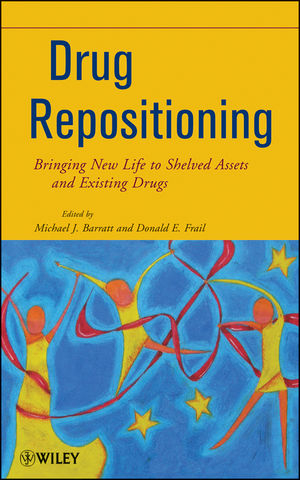
Drug Repositioning
John Wiley & Sons Inc (Verlag)
978-0-470-87827-9 (ISBN)
The how's and why's of successful drug repositioning
Drug repositioning, also known as drug reprofiling or repurposing, has become an increasingly important part of the drug development process. This book examines the business, technical, scientific, and operational challenges and opportunities that drug repositioning offers. Readers will learn how to perform the latest experimental and computational methods that support drug repositioning, and detailed case studies throughout the book demonstrate how these methods fit within the context of a comprehensive drug repositioning strategy.
Drug Repositioning is divided into three parts:
Part 1, Drug Repositioning: Business Case, Strategies, and Operational Considerations, examines the medical and commercial drivers underpinning the quest to reposition existing drugs, guiding readers through the key strategic, technical, operational, and regulatory decisions needed for successful drug repositioning programs.
Part 2, Application of Technology Platforms to Uncover New Indications and Repurpose Existing Drugs, sets forth computational-based strategies, tools, and databases that have been designed for repositioning studies, screening approaches, including combinations of existing drugs, and a look at the development of chemically modified analogs of approved agents.
Part 3, Academic and Non-Profit Initiatives & the Role of Alliances in the Drug Repositioning Industry, explores current investigations for repositioning drugs to treat rare and neglected diseases, which are frequently overlooked by for-profit pharmaceutical companies due to their lack of commercial return.
The book's appendix provides valuable resources for drug repositioning researchers, including information on drug repositioning and reformulation companies, databases, government resources and organizations, regulatory agencies, and drug repositioning initiatives from academia and non-profits.
With this book as their guide, students and pharmaceutical researchers can learn how to use drug repositioning techniques to extend the lifespan and applications of existing drugs as well as maximize the return on investment in drug research and development.
Michael Barratt is an independent consultant and previously?Senior Director and Technology Platform Leader at Pfizer's Global Indications Discovery Research Unit. He has?over 15?years of experience in preclinical drug discovery research and leadership. Donald Frail is an independent consultant and previously?Vice President of Pfizer Global Research and Development and Head of Pfizer's Global Indications Discovery Research Unit. He has over 20 years of industrial research and management experience in preclinical drug discovery and early clinical research.
About the Editors xv
Acknowledgments xvii
Contributors xix
Introduction 1
Michael J. Barratt and Donald E. Frail
References 5
Part I. Drug Repositioning: Business Case, Strategies, and Operational Consideration 7
1. Drug Repositioning: The Business Case and Current Strategies to Repurpose Shelved Candidates and Marketed Drugs 9
John Arrowsmith and Richard Harrison
2. Opportunities and Challenges Associated with Developing Additional Indication for Clinical Development Candidates and Marketed Drugs 33
Donald E. Frail and Michael J. Barratt
3. Clinical and Operational Considerations in Repositioning Marketed Drugs and Drug Candidates 53
Damian O’Connell, David J. Sequeira, and Maria L. Miller
4. Regulatory Considerations and Strategies for Drug Repositioning 65
Ken Phelps
Part II. Application of Technology Platforms to Uncover New Indications and Repurpose Existing Drugs 89
5. Computational and Bioinformatic Strategies for Drug Repositioning Drugs 91
Richard Mazzarella and Craig Webb
6. Mining Scientific and Clinical Databases to Identify Novel Uses for Existing Drugs 137
Christos Andronis, Anuj Sharma, Spyros Deftereos, Vassilis Virvilis, Ourania Konstanti, Andreas Persidis, and Aris Persidis
7. Predicting the Polypharmacology of Drugs: Identifying New Uses through Chemoinformatics, Structural Informatics, and Molecular Modeling-Based Approaches 163
Li Xie, Sarah L. Kinnings, Lei Xie, and Philip E. Bourne
8. Systematic Phenotypic Screening for Novel Synergistic Combinations: A New Paradigm for Repositioning Existing Drugs 207
Margaret S. Lee
9. Phenotypic In Vivo Screening to Identify New, Unpredicted Indications for Existing Drugs and Drug Candidates 253
Michael S. Saporito, Christopher A. Lipinski, and Andrew G. Reaume
10. Old Drugs Yield New Discoveries: Examples from the Prodrug , Chiral Switch, and Site-Selective Deuteration Strategies 291
Adam J. Morgan, Bhaumik A. Pandya, Craig E. Masse, and Scott L. Harbeson
Part III. Academic and Nonprofit Initiatives and the Role of Alliances in the Drug Repostioning Industry 345
11. Repurposing Drugs for Tropical Disease: Case Studies and Open-Source Screening Initiatives 347
Curtis R. Chong
12. Drug Repositioning Efforts by Nonprofit Foundations 389
13. Business Development Strategies in the Repositioning Industry 433
Aris Persidis and Elizabeth T. Stark
14. A Case Study in Drug Repositioning: Sosei 445
Akinori Mochizuki and Makiko Aoyama
Appendix Additional Drug Repositioning Resources and Links 457
Mark A. Mitchell and Michael J. Barratt
Index 469
| Verlagsort | New York |
|---|---|
| Sprache | englisch |
| Maße | 165 x 241 mm |
| Gewicht | 1361 g |
| Themenwelt | Medizin / Pharmazie ► Medizinische Fachgebiete ► Pharmakologie / Pharmakotherapie |
| Naturwissenschaften ► Chemie | |
| Technik | |
| ISBN-10 | 0-470-87827-4 / 0470878274 |
| ISBN-13 | 978-0-470-87827-9 / 9780470878279 |
| Zustand | Neuware |
| Haben Sie eine Frage zum Produkt? |
aus dem Bereich


